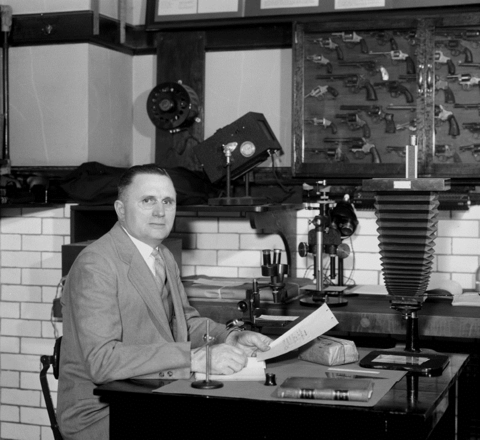The Rediscovery of the NBS Crime Lab

Wilmer Souder (aka “Detective X”) in his NBS lab.
Or How an NBS Dental Materials Researcher Became ‘Detective X’
“Is that a corpse?” As the NIST Museum curator, I find unusual things in the historical collections from time to time. But finding a photograph of a dead man in the NIST Archive was a first for me. It was discovered in the early days of my research into the career of Wilmer Souder (1884–1974). I was moving between one surprising find to another interesting lead, falling deeper into a parallel universe wherein an NBS physicist known for his research on dental amalgam fillings was also a leading figure in scientific crime detection.
My fellow NIST researchers, John Butler and Robert Thompson—both leading forensic scientists themselves—were less impressed by a photo of a dead body. The fact that it belonged to notorious gangster John Dillinger (1903–1934), however, was of significant interest to them. Together we started digging. We found the National Bureau of Standards crime lab, long buried by the sands of time.
The genesis of the lab dates back to the 1920s, a time of escalating organized criminal activity. Government agencies, with a vested interest in law enforcement, moved to counteract this shift in power and authority. One tool in particular became important in the quest to identify and prosecute criminals: science. NBS was asked to look at methods and instruments that could be developed to help identify a criminal by his or her handwriting or typewriting. The job went to Souder (rhymes with “chowder”), someone comfortable with both instrument design and precision metrology.
Initially, NBS intended to publish guidelines for forensic analysis of handwriting, typewriting, and firearms sometime in 1930. But nothing came of it. By that point, Souder had moved beyond abstract research and had engaged directly with casework. Like many of the experts of the day, he was fearful that published information about the latest methods for scientific crime detection could be used by criminals to cover their tracks. This affected how much information he released and where he released it, keeping mostly to professional newsletters.
His reticence makes our historical research that much harder. We rely heavily on a collection of Souder’s personal notebooks that date between 1929 and 1954, and archival documents held in various public and private collections. The picture they paint is incomplete, but that makes it no less interesting. In a span of 25 years, Souder conducted more than 838 analyses of handwriting, typewriting or bullets. Agencies within the U.S. Treasury, Department of Justice, Post Office, and Department of the Interior made the majority of requests for his analysis. There would have been many more, save for Souder’s requirement that the work concern the federal government in some way.
For every rule, there is an exception. For Souder, the kidnapping case of Charles Lindbergh Jr. was such a one. He felt it was the most difficult case he encountered in his long career. Between the 1932 kidnapping of the Lindbergh baby and the 1935 trial of Bruno Richard Hauptmann for the baby’s murder, Souder analyzed about 10,000 documents related to the case—all while navigating between two huge personalities vying for control of the case: Col. Norman Schwarzkopf of the New Jersey State Police and J. Edgar Hoover of the Federal Bureau of Investigation. Souder’s participation as one of the handwriting experts in the case would catch the attention of newspapers, which was unusual for someone often described as “publicity-shy.”
During his career, he was frequently called on to testify in court, often in high-profile cases. Fearing for his personal safety and that of his family, Souder mostly avoided cameras and reporters. He preferred to work behind the scenes, training others to analyze questioned documents and compare microscopic striations left on fired bullets. He found other ways to disseminate his methods, as well, such as giving invited lectures to the Washington, D.C., police department, reviewing forensic findings, and suggesting equipment for the FBI’s fledgling laboratory. These activities were likely more impactful than a published list of guidelines would have been.
In 1951, Reader’s Digest dubbed Souder “Detective X,” and upon his retirement in 1954, one newspaper declared that “the underworld will rejoice.” As it turned out, the NBS crime lab would not outlive Souder’s tenure at the agency. He was allowed to train numerous others, but not a replacement. The FBI and Postal Inspection Service labs Souder advised quickly took off, though.
Times were changing. NBS was fundamentally altering the way it did business— shifting priority to basic standard-setting and measurement programs, after being embroiled in an automobile-battery-acid controversy that took over headlines in the early 1950s. There was no one left to carry forth the memory of the abandoned crime lab. And so, it was forgotten.
But times are changing again. NIST’s role in forensic science is on the rise, and so, too, is interest in NBS’ early history in the field. I often think of this when walking by my favorite quote engraved under a statue at the National Archives building: “What is past is prologue.”
Originally published in NIST Connections: A Newsletter for NIST Employees and Associates, June 2016, p. 1-2.

